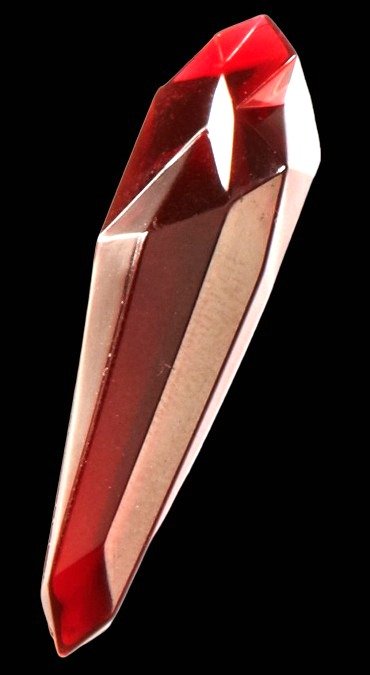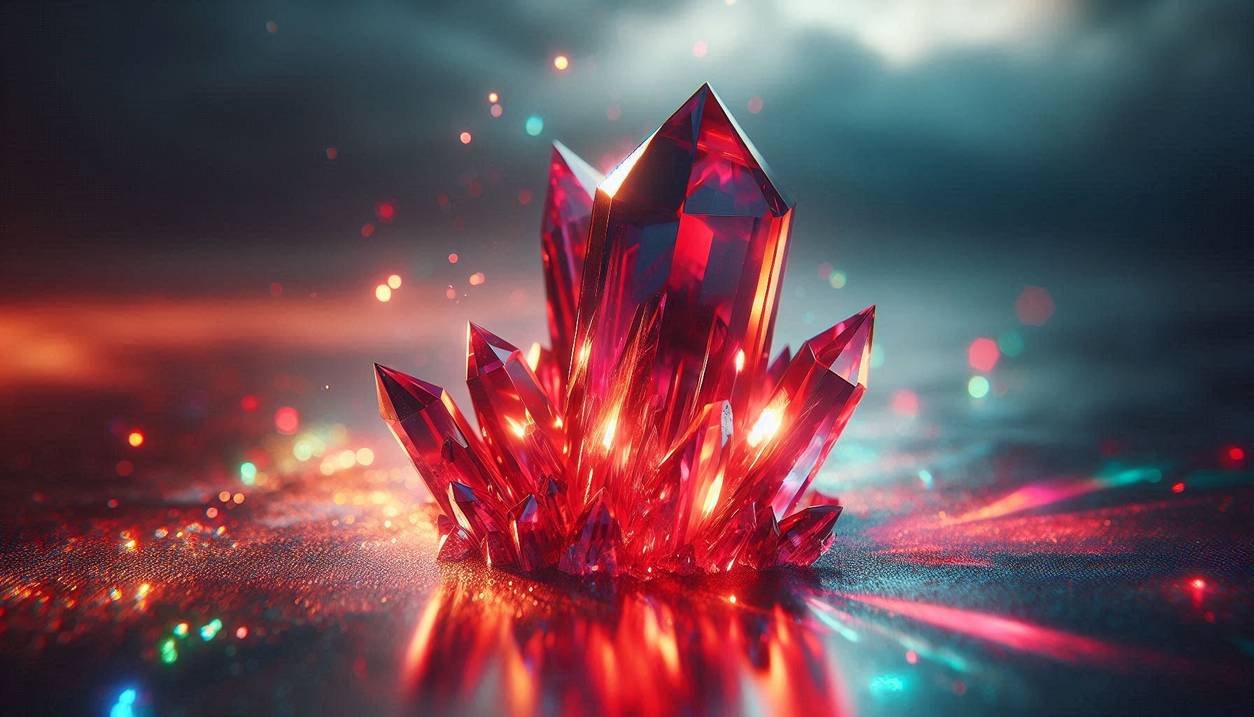1. What are Lightsaber Crystals?

Lightsaber crystals were a diverse group of crystals, gems, stones, and other objects that served as the energy source for a lightsaber.
At the core of every lightsaber was a single crystal that resonated to generate the powerful, efficient blade. While crystals from the Adega system, Ilum, and Dantooine’s Crystal Cave were the most commonly used, both Jedi and Sith employed a variety of crystals to produce different lightsaber colors, effects, and unique abilities.
Some crystals could even enhance a user’s Force abilities. Additionally, certain gems, like colored crystals or diamonds, were used solely for their prismatic effects. However, not all lightsaber focus crystals were true “crystals.” Many Jedi and Sith substituted other materials or substances, such as physical remains, glass shards, or specialized micro machinery, for a crystal.
During the Great Sith War era, many lightsabers were crafted using Kunda stones, a natural geological formation from the planet Kadril, instead of crystals. These stones had various practical uses in medicine and communications, but when combined with other focusing crystals, they produced a wider beam.
2. What is a Synthetic Lightsaber Crystal?
A synthetic lightsaber crystal, also called a Synth-crystal, was a type of lightsaber crystal that was manufactured artificially rather than developing through natural geological processes.
Due to the methods used in their production, they typically appeared red in color, although they could be crafted in any hue with special alterations to the creation process or the crystal itself, often utilizing the Force, such as the green synth-crystal used in Luke Skywalker’s second lightsaber.
3. Overview
Although synthetic crystals were generally unsuitable for lightsaber use, the Sith learned to create specialized synth-crystals by energizing, magnetizing, and infusing them with the dark side of the Force in custom furnaces, causing the crystal to glow harmonically. Because of their artificial origin, synthetic crystals produced more powerful lightsaber blades and were easier to enhance. Their frequent use by the Sith and other Dark Side users after this discovery made synthetic crystals a common feature among such groups, while the Jedi strongly discouraged their use.
Most synthetic crystals were red, a result of the creation process and the intentional manipulation of the user, as most individuals utilizing synthetic crystals followed the Dark Side. The red lightsaber blades produced by these crystals were commonly called “bloodshine blades.” The crystal’s ability to adapt to the user’s intent could be seen as fostering a stronger connection between the lightsaber and its wielder. However, synth-crystals could be crafted in any color with only slight changes to the creation process and special Force manipulations during forging.
4. Manufacturing Process

Synthetic lightsaber crystals were produced within a machine known as a geological compressor. Initially designed to replicate the geological conditions of distant planets in a lab, the machine was easily modified to create synth-crystals by mimicking natural geological processes.
The raw materials, typically minerals rich in carbon, were simple to obtain. Once placed in the machine, these minerals were left to process for anywhere between twenty-four hours to four days.
During this time, the user meditated on the crystal using the Force to guide its formation and enhance its potency. This degree of control over the process allowed users to create crystals that suited their needs.
5. Properties and Differences from Natural Kyber Crystals
Synthetic crystals exhibit several key differences from natural kyber crystals, both visually and in terms of their properties. Physically, synthetic crystals are less stable, leading to a more erratic or volatile lightsaber blade. Visually, they tend to produce deeper, more intense colors, especially the red hue associated with the Sith.
Beyond aesthetics, synthetic crystals have unique properties. They can be tuned to enhance a lightsaber’s destructive potential, producing blades with greater energy output than natural kyber crystals. However, they are also more challenging to attune with the Force, often resisting the user’s connection and creating a less harmonious relationship between the blade and its wielder. This instability sometimes manifests in the lightsaber’s appearance, resulting in an erratic or flickering blade, as seen in some Sith weapons.
6. Advantages and Disadvantages
There are several key advantages and disadvantages of synthetic crystals that set them apart from natural kyber crystals.
6.1 Advantages:
- Customizable Properties: Sith alchemists could manipulate synthetic crystals during their creation to enhance specific traits, like energy output or color.
- Power: Synthetic crystals could generate more powerful and destructive lightsaber blades, making them ideal for Sith warriors focused on offense.
- Control: The ability to force the growth and properties of synthetic crystals gave Sith Lords a greater sense of dominance over their weapons.
6.2 Disadvantages:
- Instability: Synthetic crystals were often less durable and more prone to failure, leading to potential problems with the lightsaber’s stability.
- Connection to the Force: Synthetic crystals were more difficult to attune to, leading to challenges for Sith users who relied heavily on the Force in combat.
- Unpredictability: The unnatural nature of synthetic crystals often led to unpredictable properties, such as erratic blade behavior or unexpected energy fluctuations.
7. Types of Synthetic Crystals
Along with the various colors, synthetic crystals could be modified to focus lightsaber blades differently.
7.1 Standard Synthetic Crystals
A standard synthetic crystal was made by accurately replicating the geological structure of natural crystals. Standard crystals became the benchmark for synthetic crystals, producing more powerful lightsaber blades than their natural counterparts and often exhibiting a red hue, though this could be controlled. In fact, synth-crystal blades were so powerful they could potentially “break the blade” of a standard lightsaber by overloading the energy matrix and instantly burning out the other lightsaber. Although this occurred rarely, it remained a recognized and feared possibility in combat.
However, lightsaber blades generated by synth-crystals were typically less maneuverable than those produced by natural crystals and were generally less stable.
7.2 Compressed Synthetic Crystals
Compressed synth-crystals were created when the natural geological process for forming crystals was inaccurately replicated. These crystals were much more compressed than natural ones, resulting in blades significantly thinner than standard lightsaber blades. However, the thinner blade allowed for greater precision and control. Additionally, these blades often exhibited rapid energy oscillations along their length at regular intervals.
7.3 Unstable Synthetic Crystals
Unstable crystals, like compressed crystals, were the result of a failure to replicate natural crystal formation accurately. The blades generated by these crystals were noticeably more unstable, crackling with energy at irregular intervals and occasionally emitting sparks or streaks of electrical energy. Due to this unstable energy, lightsabers using these crystals dealt more damage upon contact, though they were prone to shorting out and deactivating temporarily.
8. Historical Background
8.1 Early Usage by Sith
It is unclear when the Sith and other Dark Side factions began utilizing synthetic crystals, although red crystals were in use as early as the Old Sith Empire, with figures like Karness Muur and his followers wielding weapons powered by such crystals. During that era, however, most Sith wielded Sith swords instead of lightsabers, though red lightsabers became the standard weapon after the Empire’s reformation.
8.2 Adoption by Dark Jedi
The first Sith follower to adopt a red-bladed weapon before the Old Empire’s resurgence was the Dark Jedi Haazen, while previous Dark Lords, such as Exar Kun and his followers, continued using their Jedi lightsabers in combat. When Darths Revan and Malak rose to power, red crystals became widely used among their Sith followers. The widespread use of red-hued crystals within Revan’s Sith Empire cemented them as the hallmark of Dark Side users.
8.3 Reasons for Synthetic Crystal Usage
The primary reason for the Sith and other Dark Side users’ reliance on synthetic crystals was the need to remain hidden, as most locations where natural lightsaber crystals could be found were monitored by the Jedi Order. Over time, the use of synth-crystals became a tradition among these groups, with many considering the creation of synthetic crystals superior to the more passive Jedi practice of collecting natural crystals, which was viewed as depending on the “untamed wilds of space.” Dark Side users believed that creating synthetic crystals demonstrated greater mastery over the Force.
8.4 Jedi Perspectives on Synthetic Crystals
On the other hand, the Jedi disapproved of their initiates crafting and using synth-crystals, associating it with the quick and easy path. They believed they should rely on naturally occurring crystals.
However, there were occasions when Jedi were forced to create synth-crystals when natural crystals were unavailable, as seen with Luke Skywalker, who used a synth-crystal for his first lightsaber due to his lack of knowledge about natural crystals, and his niece, Jaina Solo. Jedi-made synth-crystals usually had colors other than red to avoid association with the Sith. Skywalker crafted a green crystal, while Solo created a violet one.
Under the rule of Emperor Palpatine (Darth Sidious), the Galactic Empire looted or destroyed nearly all natural crystal sources, forcing the New Jedi Order to rely almost entirely on synthetic crystals.
8.5 Imperial Knights and Synthetic Crystals
The Imperial Knights used synthetic crystals in their lightsabers, crafting them using knowledge from Sidious’ Book of Anger without any ceremony or deeper significance. To an Imperial Knight, a lightsaber was just a tool, with their training also focusing on combat in vehicles, hand-to-hand fighting, and the Force. These lightsabers had silver-white blades.
8.6 Natural Red Crystals
Not all red lightsaber crystals were synthetic. Red Adegan crystals existed, and Darth Vader used one in one of his lightsabers. Additionally, red-hued crystals formed naturally in the Crystal Cave on Dantooine, alongside blue, green, yellow, and violet crystals. However, unlike the others, red crystals from Dantooine were typically found within unhatched kinrath eggs.
9. Synthetic Crystals in Star Wars Canon and Legends
In modern Star Wars canon, synthetic crystals have taken a back seat to the concept of “bleeding” crystals. Sith no longer synthesize crystals from scratch but instead corrupt natural kyber crystals, forcing them to “bleed” and turn red through intense Dark Side rituals. This process highlights the Sith’s destructive influence on the Force.
In the old Star Wars Legends continuity, synthetic crystals were a common feature of Sith lightsabers. They were explicitly crafted by the Sith in laboratories, representing their technological mastery and manipulation of the Force. While synthetic crystals have faded in modern canon, they remain an essential part of Legends’ portrayal of the Sith’s dark legacy.
Explore Our Lightsaber Collection
Tony Allen is a writer for LightsabersBlog.com, a website focused on everything related to lightsabers. Tony grew up in Austin, Texas, and went on to study Mechanical Engineering at the University of Texas. Passionate about science fiction and fantasy, Tony has always been deeply involved in hobbies like tabletop RPGs, sci-fi novels, miniature painting, and crafting. This love for creative pursuits drives Tony to write about lightsabers in a way that ignites the imagination of fans around the world.









































